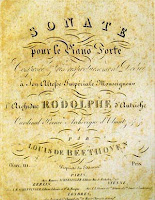Franz Liszt, the creator of the modern recital, suffered slightly disappointed after visiting Italy in 1838 and performing as a concert pianist at Milan's Alla Scala. The audience, no doubt, would have roared with enthusiasm if the 27-year-old Hungarian maestro had offered them part of his vast repertoire of piano transcriptions of bel canto opera. But he didn't. This time Liszt appeared with a repertoire made up entirely of Beethoven sonatas, convinced that it was time for the master from Bonn, who had been missing for eleven years, to be considered at the height of his stature by the public at large. The opposite was true: the common Milanese audience was not yet at Beethoven's level.
Waiting for the 20th century
We do not know the sonatas Liszt played for this occasion, but it is to be expected that he did not include the last three, which are more difficult to digest for the common public. In fact, a great Polish pedagogue, in the middle of the 19th century, advised his students simply not to study them, although the reason was mainly economic: there would be no audience to present them to. Liszt could attest to this. The public who loved Beethoven's complete sonatas will only emerge in the 20th century thanks to technology. Through the use of players, it was possible to bring back home that music that had been conceived a hundred years ago to be listened to serenely and attentively by a small group of people.
The triptych
In the course of three years, from 1820 to 1822, Beethoven undertook the composition of the triptych made up of his three last sonatas, publishing in each year, the opus 109, 110, and 111. During these years, the master's health deteriorated. Nevertheless, he was able to alternate this work with the writing of pieces as great as the Missa Solemnis or the resolution of the finale of the Ninth Symphony. It seems that the maestro knew how to make the most of the moments when, despite everything, he seemed to "feel a new life", as he wrote in his notes.
 |
| Title page of the first edition |
Certainly, the late sonatas are not Beethoven's most popular. But only a few of the latter can rival in depth and richness of sound with the last sonata, the Sonata in C minor No 32, opus 111, considered one of the greatest piano sonatas ever written, capable of leading the listener into sound worlds hitherto unknown, let alone explored.
Novel rhythmic patterns
Published in 1822, it is dedicated, like so many others, to his friend and mentor, Archduke Rudolph. In its construction, Beethoven departs from convention and writes only two movements, which he calls Maestoso and Arietta, the latter the longest, with a structure of theme and variations. Surprisingly for those who listen to it for the first time, the second movement contains rhythmic patterns that only a hundred years later will be heard again and will be a novelty to the point of receiving denominations hitherto unheard in music: swing and boogie-woogie.
Movements:
00 Maestoso: Allegro con brio ed appassionato
9:02 Arietta: Adagio molto, semplice e cantabile. Theme and variations:
Var I: 11:43
Var II: 13:45 (the swing starts)
Var III: 15:30 (the boogie-woogie starts)
Var IV: 17:39
Var V: 20:55
Var VI: 22:44
The performance is by Chilean maestro Claudio Arrau.

No comments :
Post a Comment